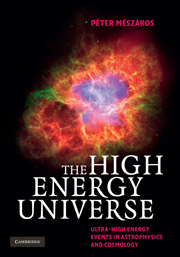Book contents
- Frontmatter
- Dedication
- Contents
- Preface
- 1 Introduction
- 2 The nuts and bolts of the Universe
- 3 Cosmology
- 4 Cosmic structure formation
- 5 Active galaxies
- 6 Stellar cataclysms
- 7 Gamma-ray bursts
- 8 GeV and TeV gamma-rays
- 9 Gravitational waves
- 10 Cosmic rays
- 11 Neutrinos
- 12 Dark dreams, Higgs and beyond
- Epilogue
- References
- Glossary
- Index
2 - The nuts and bolts of the Universe
Published online by Cambridge University Press: 05 July 2014
- Frontmatter
- Dedication
- Contents
- Preface
- 1 Introduction
- 2 The nuts and bolts of the Universe
- 3 Cosmology
- 4 Cosmic structure formation
- 5 Active galaxies
- 6 Stellar cataclysms
- 7 Gamma-ray bursts
- 8 GeV and TeV gamma-rays
- 9 Gravitational waves
- 10 Cosmic rays
- 11 Neutrinos
- 12 Dark dreams, Higgs and beyond
- Epilogue
- References
- Glossary
- Index
Summary
The building blocks: elementary particles
2.1.1 Atoms and quanta
We are all familiar with the concept of atoms. We are made out of them, our surroundings are made out of them, and our Universe is made out of them. The name derives from the Greek, meaning “indivisible”, which conveys the idea that these are the smallest building blocks out of which the Universe is built. In the early 1900s the smallest units were indeed considered to be the atoms, consisting of a central more massive kernel, the nucleus, surrounded by a cloud of orbiting, much smaller and lighter particles called the electrons. The electrons were found to have negative electrical charge, while the much heavier nucleus had an equal amount of positive electrical charge, which was attributed to heavy particles called protons. Later, in the early 1930s, it was found that the nucleus contained other particles as well, slightly heavier than the protons but electrically neutral, which were consequently given the name of neutrons.
For a while these appeared to be all of the basic building blocks of matter. Different atoms, such as hydrogen, helium, carbon, iron, etc., consisted of a nucleus which differed by containing increasing amounts of protons, and except for hydrogen, a comparable or slightly larger number of neutrons, and around the nucleus a number of electrons matching the number of protons, so as to ensure electrical neutrality. This was thought to be what ordinary matter consists of, and in fact this picture continues to be basically correct to this day, except for the fact that it is not the complete picture.
- Type
- Chapter
- Information
- The High Energy UniverseUltra-High Energy Events in Astrophysics and Cosmology, pp. 11 - 30Publisher: Cambridge University PressPrint publication year: 2010



